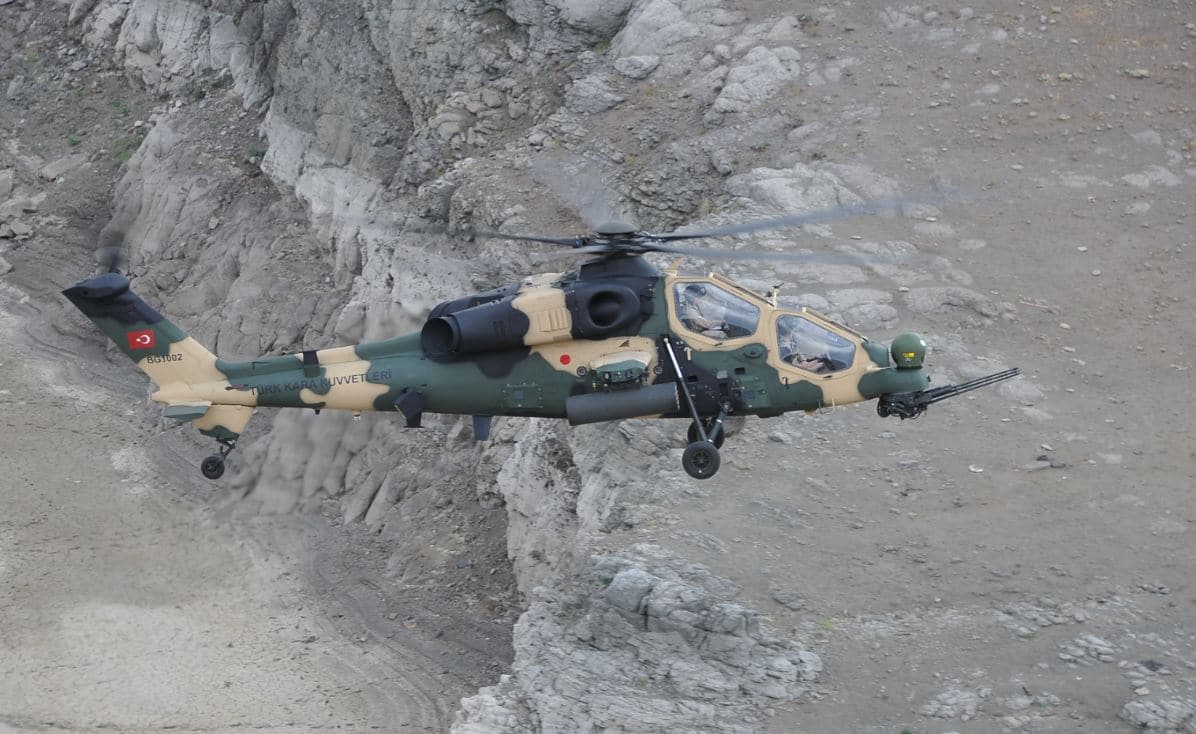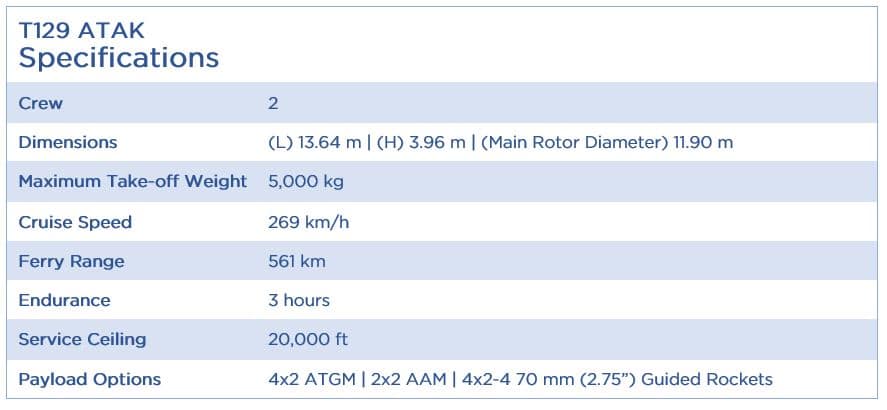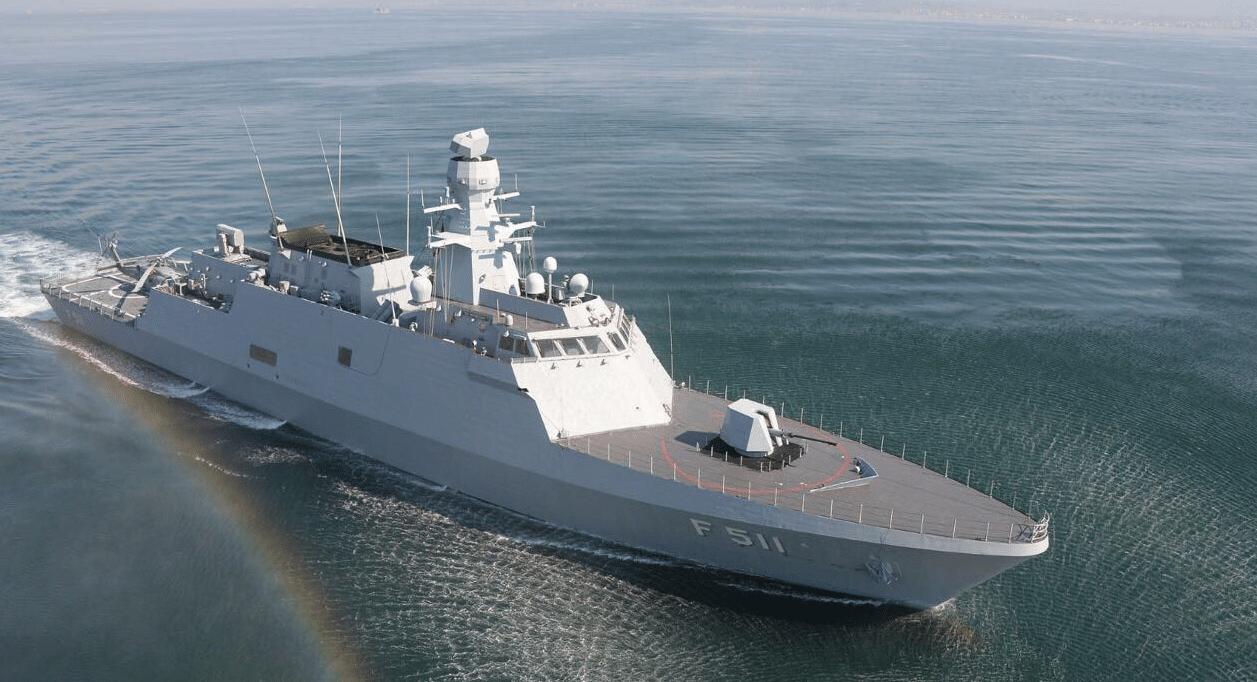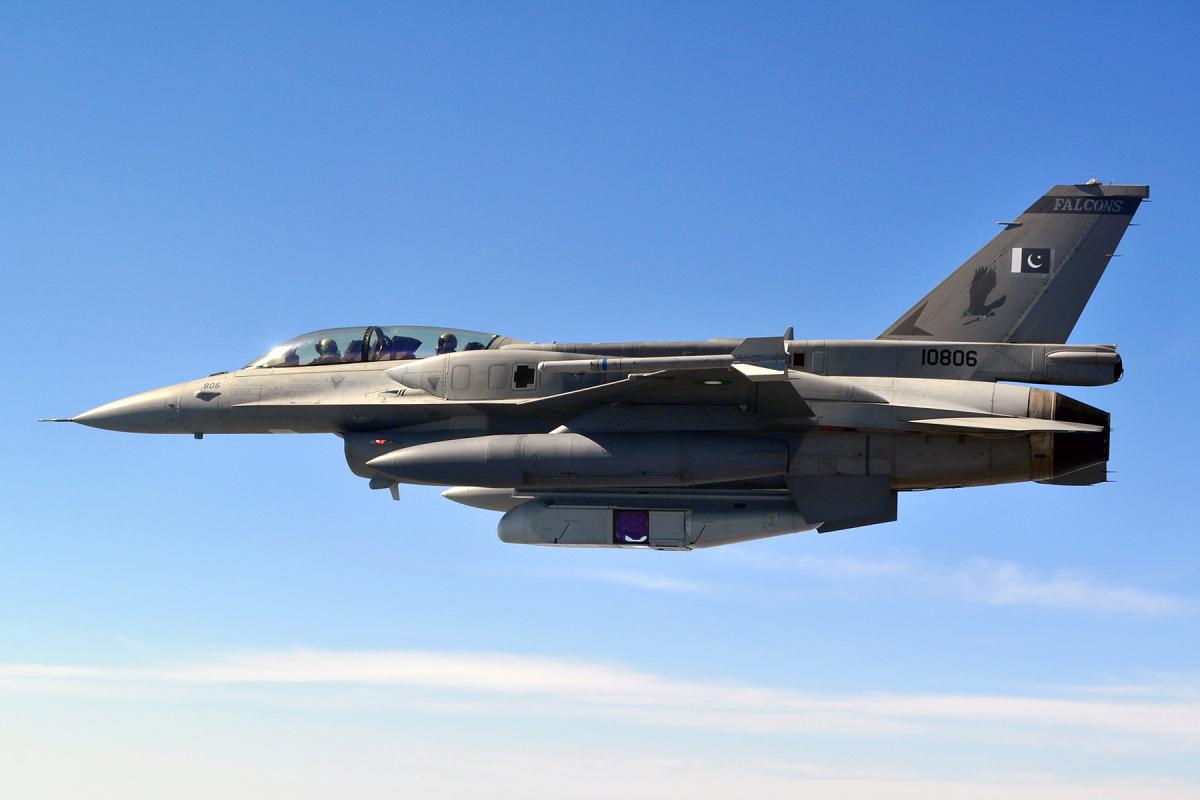40Views 35Comments

Discussion: Pakistan’s pursuit for T129 attack helicopters and future industry and acquisition paths
Foreword: This is not a news story, but a piece for discussion. The details offered in this article are not authoritative pieces of information, but rather, opinions of the author.
On his official visit to Turkey earlier in October, Pakistan’s Prime Minister Shahid Khaqan Abbasi confirmed that Islamabad was in talks with Ankara for the purchase of Turkish Aerospace Industries (TAI) T129 ATAK attack helicopters. The Pakistan Army is reportedly seeking 30 T129s in a deal worth $1.5 billion U.S. with Pakistan Aeronautical Complex (PAC) potentially taking-on parts manufacturing and final assembly work. If matters proceed, a breakthrough could be had by July 2018 in time for the Farnborough Air Show. If brought to fruition, this sale will be Turkey’s largest defence export program to-date and it would also be among a handful of big-ticket defence programs unfolding in Pakistan.
On the surface, the Pakistan Army Aviation (PAA) Corps requires the T129s to replace its aging Bell AH-1F and AH-1S Cobra attack helicopters, which have seen extensive use in Pakistan’s counterinsurgency (COIN) and counterterrorism (CT) operations in the Federally Administered Tribal Areas (FATA).
However, by connecting PAC to the program right from the onset, the T129 program has the potential to fuel Pakistan’s aviation industry sector and to enable the launch of substantive helicopter manufacturing work at PAC. The timing certainly bodes well seeing how closely it ties with the launch of the Kamra Aviation City initiative, which envisages building a robust aviation industry in Pakistan.
Attack Helicopters as CAS Assets
In 2016, Pakistan ordered 12 Bell Helicopter AH-1Z Viper and four Russian Helicopters Mi-35M. The latter have apparently been delivered, while the first two AH-1Z appear to be ready for delivery. It is not clear if additional orders are on the roadmap. The U.S. State Department had approved the sale of 15 AH-1Z to Pakistan in 2015, while IHS Jane’s was told that the Pakistan Army was interested in a total of 20 Mi-35M. The TAI T129 ATAK would effectively form the mainstay of this force, but as a lighter complement to the AH-1Z. The T129 and AH-1Z have maximum take-off weights (MTOW) of 5-tons and 8+ tons, respectively.
The intended final number of attack helicopters required by the Army is not known. However, one could argue that the provision of parts manufacturing and final assembly at PAC could set the stage for follow-on orders, especially in incremental batch orders (e.g. three or four helicopters per year). Following the initial order of 30 helicopters, 10-15 years of incremental orders could yield another 30-60 of T129s. With PAC involved in the production process, a portion of that expense would be spent locally. Granted, this is contingent on fiscal space and the Army’s requirements.
In 2016, Quwa had argued that strengthening the PAA should be the leading focus of building Pakistan’s close air support (CAS) capabilities. While the Pakistan Air Force (PAF) has invested in improving its strike capabilities, the utility of PAF assets is highest against high-value fixed installations. In COIN, those targets have been ammunition dumps and tunnels, while in conventional war such targets could include military installations and infrastructure critical to the adversary’s war effort. However, low-altitude coverage for infantry and armour, or engaging moving and time-sensitive targets, necessitate specific CAS assets.
If this CAS coverage net is relevant beyond COIN/CT – i.e. to include conventional infantry and/or armour operations – then the PAA would likely require a quantitatively large attack helicopter fleet. Sustainably achieving this goal necessitates a platform that has feasible acquisition and operational costs, especially from a maintenance standpoint. In turn, that will require localizing the maintenance and support channel, not only for lowering costs, but to ensure that immediate operational requirements are not impacted by sanctions or other supplier complications. The helicopter would also need to be operable in Pakistan’s varied environments, which include deserts, plains, mountainous areas/valleys and high-altitude peaks.
Sufficiency in range and payload is difficult to judge. First, the legacy AH-1F/S has a MTOW of 4.5 tons, while modern lightweight attack helicopters, such as the T129 and Light Combat Helicopter (LCH), have MTOWs of 5 tons and 5.5 tons, respectively. Second, Pakistan’s future conflicts – be it COIN/CT or conventional – are within its own region. In other words, Pakistan is unlikely to deploy its helicopters in distant expeditions with limited logistics support, at least not often (Pakistan did deploy an AH-1S unit to Somalia under a United Nations mandate in 1994). In other words, the focus is unlikely to be on heavy payloads, which could be found on the AH-64E, Mi-28NE and Rooivalk Mk2.
Selecting the T129 ATAK
Pakistan had evaluated the Changhe Aircraft Industries Corporation (CAIC) Z-10 and TAI T129 in 2016. By this point it had already ordered the 12 AH-1Z, so these helicopters – both of which were lighter than the AH-1Z – were sought to complement the Viper. In 2015, China sent three Z-10s to the Pakistan Army, and the Pakistan Army deployed them in various environments, including desert operations (via exercises) and reportedly even COIN/CT combat operations in FATA. The T129 visited Pakistan for a much briefer period, during which the Army tested its performance in hot-and-high conditions and desert areas.
On the surface, the Z-10 and T129 have similar subsystems. They are equipped with electro-optical and infrared (EO/IR) turrets with laser rangefinders and target designators, radar warning receivers (RWR), helmet mounted display and sight (HMD/S), passive and active countermeasures and compatibility with anti-tank guided missiles (ATGM). Payload wise, the Z-10 and T129 each appear to have the capacity to carry eight ATGMs alongside a cannon. These were comparable platforms.
In terms of evaluating the T129, the Pakistan Army began the process in 2014 in Turkey. An Army team sent to Turkey was reportedly impressed with its performance. Under a framework agreement signed with the Turkish Undersecretariat of Defence Industries (SSM), a T129 ATAK was sent to Pakistan in 2016. The T129 P6 was received at Army Aviation Command in Multan on May 22, 2016.
According to TAI (via MSI Turkish Defence Review)[1], the Army evaluated the T129 P6 in hot temperature conditions, high-altitude and, for a specific period, with limited logistics support. In Multan, it was 47° Celsius, while in Pano Aqil (another area where the T129 P6 was flown) it was 50° C. During its deployment test, the helicopter was put in a hangar in Quetta, an area where it did not drop below 48° C, through the night. The TAI team did not have access to spare parts and ground support equipment (GSE). From there, TAI flew the T129 to Himalayas, where the P6 was successfully flown at 14,000 ft at 23° C. It returned to Quetta, spending another night without its GSE. The final major test required TAI to directly fly the T129 from Quetta to Multan – i.e. 480 km – without any refuelling between the two locations.
The T129 ATAK is a development of the AgustaWestland A129 CBT, an upgraded variant of the A129 Mangusta. However, the T129 also draws from the A129 International, which is evident by the fact that the T129 is powered by two Light Helicopter Turbine Engine Company (LHTEC) CTS800 turboshaft engines, each providing an output of 1,361 shp. According to TAI, the T129 also includes “new avionics, visionics and weapons, modified airframe, uprated drive train and new tail rotor.” In August 2017, a TAI official claimed that the T129 possessed highly competitive life-cycle costs.

Of the potential ‘plus-one’ attack helicopters to join the AH-1Z, the Pakistan Army did not evaluate heavy-weight platforms. There had been reports of Pakistan expressing interest in the Russian Helicopters Mi-28NE Night Hunter (11 tons), but formal evaluation has yet to occur (if it will at all). It is not clear if Pakistan has an active requirement for a heavyweight platform, which would have notable payload advantages over the T129. With a MTOW of 8+ tons, the AH-1Z could be the heavyweight complement to the T129. TAI will also develop a heavier 6-ton variant of the T129 in the form of the ATAK-2, which will also use TUSAŞ Engine Industries’ (TEI) turboshaft engine. Initiating a partnership over the ATAK could also be a bridge to collaborating on the ATAK-2. Considering its desire to build an aviation industry, Pakistan may need to eschew off-the-shelf imports in favour of co-production and/or development partnerships. While the ATAK-2 would still be lighter than the AH-1Z and Mi-28NE, engaging in that program could better serve Pakistan’s domestic industry growth. Alternatively, Pakistan could examine another developmental route, such as the Denel Aeronautics Rooivalk Mk2. However, Pakistan’s limited fiscal means will restrict it from pursuing two largely overlapping development programs in parallel.
Besides taking over the manufacturing of the T129, the Turkish industry has been responsible for providing the T129’s electronics suite. Specific inputs include Aselsan’s integrated avionics comprising of multi-function displays (MFD), inertial navigation system (INS), data loading unit, control panels, communication system, digital moving map system, ASELFLIR-300T EO/IR turret, AVCI HMD/S and passive as well as active self-protection/countermeasures systems. Roketsan’s UMTAS laser-guided ATGM and CİRİT 2.75” laser-guided rockets are the T129’s principal munitions. Havelsan has also developed a T129 simulator system.
Linkage to Pakistan Aeronautical Complex and Industry Opportunities
Linking PAC to the Army T129 from the onset indicates a long-term investment. Granted, parts production and final assembly at PAC would enable Pakistan to save on foreign currency outflows to an extent, but there is also a cost to raising infrastructure. It would make sense for Pakistan to scale the infrastructure overhead by building a relatively sizable T129 fleet. Incremental, but consistent, batch orders over 10 to 15 years could amount to such growth.
At the 2016 International Defence Exhibition and Seminar (IDEAS) in Karachi, Pakistan in November 2016, the Deputy Undersecretary of the SSM Mustafa Şeker said the T129 was “required by the Pakistan Army, Navy and Air Force. Thus, all three services are involved in the process [of evaluating the T129].”[2] It is doubtful that the PAF would engage in many CAS operations outside of special operation forces (SOF) missions, but the Pakistan Navy Marines seem to be growing in importance to Pakistan’s anti-access and area denial objectives. A CAS arm may be useful for the Marines if they are the first line of defence against an incursion along Pakistan’s adjacent coastal link with India. Alternatively, the Special Service Group Navy could use attack helicopters to support its COIN and CT operations. However, the PAF and Navy have yet to signal intent for attack helicopters, but co-production at PAC would make such procurements plausible.
However, besides co-production, it would be wise for Pakistan to raise a maintenance, repair and overhaul (MRO) facility for the LHTEC CTS800 turboshaft engine, which powers the T129. In terms of turboshaft engines, PAC raised a MRO site for the Pratt & Whitney PT6, which powers the AW139, Bell 412EP, Grand Caravan EX and King Air 350ER, each of which is used by the Pakistan Army and/or PAF. LHTEC is a joint-venture between the U.S.’ Honeywell and Rolls-Royce based in the U.K. The PAF’s K-8 Karakorum trainers are powered by Honeywell’s TFE 731-2A-2A turbofan engines, this relationship could be expanded to include the CTS800. Pakistan and the U.K also relaunched a memorandum-of-understanding (MoU) for defence technical cooperation, this could be an instrument to engage the Rolls-Royce side of LHTEC. The CTS800 has not seen much adoption beyond the T129, AW159 and T625, Pakistan could look to leverage its position as a CTS800 operator to push for licensed spare parts manufacturing.
In July, the Pakistani government and the PAF inaugurated the Kamra Aviation City complex, pairing PAC with a nearby academic campus (raised by Islamabad-based Air University). The intent of Kamra Aviation City is to foster growth in Pakistan’s aviation sector, including commercial and civil aviation. With the JF-17 and Project Azm (i.e. a medium altitude long-endurance drone and 5th-generation fighter) forming the desired long-term objectives of the initiative, the T129 program could be a valuable driver for near-term activity (outside of the JF-17). It would pave the way for helicopter-related activities at PAC, imbuing the entity with experience in the area which it could extend to future programs.
In fact, it would be ideal if this acquisition sets the framework for the Army’s future big-ticket acquisitions, especially in aviation. For example, the Army’s aging SA330/IAR330 Puma utility and transport helicopters could necessitate a replacement. If one is pursued, it ought to be done as a co-production deal akin to the T129 or a joint-venture, with the TAI 10-ton general purpose helicopter program being a plausible avenue. The TAI helicopter would be analogous in size to the Lockheed Martin/Sikorsky S-70i Black Hawk, itself a versatile design with maritime, civil services and SOF variants. With the Pakistan Navy also operating the legacy Sea King, the idea of pooling requirements could be explored as a means to build domestic scale. In fact, a platform of this nature would likely spur a higher production count considering that it is a general-purpose system, covering search-and-rescue, medical evacuation, law-enforcement and others.
Besides TAI, the Turkish companies Aselsan, Roketsan and Havelsan are also involved in the T129 ATAK. It is possible that the T129’s entry to Pakistan will have these companies expand their business activities in the country. Aselsan and Havelsan are already engaged in Pakistan. Aselsan is a subsystems vendor for the Pakistan Navy’s Agosta 90B submarine upgrade program. It is also working with the National Radio Telecommunication Corporation (NRTC) to supply software defined radios to the Pakistani armed forces. Havelsan has supplied simulator systems of various kinds, including artillery forward observer training systems, to Pakistan. It is also supplying subsystems for the Agosta 90B upgrade program.
Roketsan had been eager to enter the Pakistani market. At IDEAS 2016, the company had told MSI Turkish Defence Review that it was open to supplying its ballistic armour technology for Pakistan’s tank programs, UMTAS ATGM and CİRİT laser-guided rockets, artillery shells and 122 mm and 300 mm rockets.[3] The T129 could lead to Pakistan acquiring UMTAS and CİRİT munitions. Likewise, Aselsan’s EO/IR and avionics suite and Havelsan’s simulator system would likely be factors as well. On the electronics side, the Ministry of Defence Production (MoDP) could work to connect the Pakistani private sector to Aselsan and Havelsan so that they can jointly execute T129-related contracts in Pakistan. With the PAF urging the private sector to invest in Pakistani aviation activities, enabling access to T129 sub-contracting work – especially electronics and after-sale support – could be a tangible bridge to that goal.
If finalized and brought to fruition, the T129 would be among a handful of big-ticket defence programs to unfold in Pakistan, joining the JF-17 multi-role fighter, Hangor (II)-class submarine and the al Khalid main battle tank in the near-term. A well-structured and executed program seeking to meet specific public and private sector industry goals can provide a relatively nascent aviation industry base a vital boost. This may also be the foundation for a stronger partnership with TAI, one that can extend to new programs, such as the 10-ton general purpose helicopter and potentially other solutions.
[1]“TAI T129 ATAK at the Himalayas.” MSI Turkish Defence Review. November 2016. Issue 31.
[2] “Turkey-Pakistan Defence Relations Moving to Next Level.” MSI Turkish Defence Review. January 2017. Issue 34.
[3] “Turkey-Pakistan Defence Relations Moving to Next Level.” MSI Turkish Defence Review. January 2017. Issue 34.


